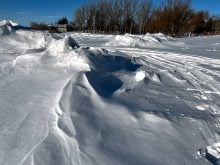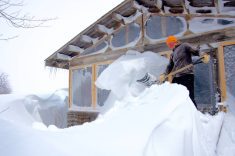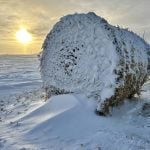If you’re a weather nut like me, you likely heard about the extreme lake-effect snowfalls that recently hit parts of Ontario and New York state. Due to the nature of the Great Lakes, they can often see truly significant lake-effect snowfalls.
In Manitoba, we too can see lake-effect snow, but not to the same extent. In this issue we’ll examine lake-effect snow and compare Manitoba’s great lake – Lake Winnipeg – to Lake Erie, the epicentre of the latest extreme lake-effect snowfall.
Lake-effect snows are exactly that: snowfall created almost solely by the moisture and energy contained within a lake. Usually when we get snowfall, it comes from storm systems, which are areas of low pressure. These systems bring moist air and force it to rise, condense and form snow. With lake-effect snow, you don’t necessarily need an area of low pressure. All you need is a large difference in temperature between the water and the air.
Read Also

What is perfect Christmas weather?
What is ‘perfect’ Christmas weather on the Prairies? Here’s where you should head this holiday, according to historical weather data.
The first and most important component of a lake-effect snowfall is warm water. Here in Manitoba, our large lakes have some heat storage, but since they are so shallow, they quickly lose their heat in the fall. This means we only have a short period in the late fall and early winter when there is open water and large amounts of heat available.
The Great Lakes, on the other hand, are much deeper and can store huge amounts of energy. With the exception of Lake Erie, it’s rare for any of the Great Lakes to totally freeze over during winter. There is plenty of warm, moist air available nearly all winter, but especially in early winter when the lakes are still fairly warm.
The second key ingredient is cold air. While the open water can supply plenty of moisture, what really comes into play is how cold the air is over the lake. The colder the air, the lower the air’s ability to hold moisture. Any moisture picked up over the lake will quickly turn into snow as it rises and cools.
When comparing Lake Winnipeg and Lake Erie, we find that surface temperatures of the lakes when lake-effect snows formed this year were around 8 C on Lake Winnipeg and 15 C on Lake Erie.
The warm water in Lake Erie extends to about 30 feet deep, so there is a lot of heat available to replace any cooling that occurs at the surface. Surface air temperatures over both lakes were around the same, -10 to -14 C, which is ideal for snow formation.
Fetch
The third piece of the lake-effect snow puzzle is wind fetch. This is the distance or length of time the wind blows across a lake. The longer the wind can blow across the water, the more heat and moisture it can pick up.
Over Lake Erie, a south-southwesterly flow gives the longest fetch.
In Manitoba, our major lakes run in a north-south direction. So, for us to see any significant lake-effect snow, winds must blow from the north for the south basin, or north-northwest over the north basin.
The shape of Lake Winnipeg means its north and south basins are not in a straight line. The two distinct basins basically break the lake into two bodies of water and reduce the fetch length. The south basin of Lake Winnipeg has a fetch length of about 85 kilometres and its north basin is about 260 km, while Lake Erie’s length is about 335 km.
The last mechanisms are friction and upslope lift. As the wind blows from the relatively smooth surface of the lake to rougher land surfaces, the air encounters increased friction. This slows the wind as it blows over the land, causing the air coming off the lake to pile up. This forces the air to rise, which helps it cool and form snow.
In some areas, the height difference between the lake and the land also helps lift the air and cool it, enhancing snowfall.
To summarize, as cold air moves over a body of water, it picks up heat and moisture from the water. This warm, moist air will begin to rise into the atmosphere. As it does, it expands and cools, allowing the moisture picked up from the lake to condense into ice crystals and eventually form snow. That snow falls downwind or on the lee side of the lake.
Unlike snowstorms that usually last a day or two, lake-effect snows can, if conditions are right, last for several days and create some truly remarkable amounts.
In Manitoba, lake-effect snows usually only last for a few hours, but there can be the occasional persistent band of snow. Usually, these only drop a couple of centimetres, but there have occasionally been larger dumps.
It’s hard to check climate records and identify lake-effect snows because there are no recording stations near to where lake-effect snows typically fall. Going by memory and reports, I’d say 20 to 30 cm is probably the top end for our region.
At the Great Lakes, record snowfalls from lake-effect snow can be remarkable. The largest event I was able to find occurred in February 2007, when a multi-day event dropped more than 358 cm of snow on the Tug Hill Plateau in New York state. What’s amazing about these snow events is the intensity, with huge amounts in a short time.
Other record-level snowfall accumulations from lake-effect snows include 25 cm in one hour at Copenhagen, N.Y., on Dec. 2, 1966; 44 cm in two hours at Oswego, N.Y. on Jan. 26, 1972; and 168 cm in 24 hours at Orchard Park, N.Y. on Nov. 19, 2022.
















